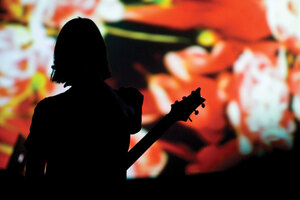Distinguished psychedelic band plays to loyal fans
Like the band Porcupine Tree, the scene at Club Nokia on Saturday night was difficult to define. The audience ranged from high school students wearing freshly bought band T-shirts to middle-aged men with long hair and long-forgotten dreams of beginning their own rock bands. Despite the differences in age and style, the audience was a powerful force and packed the venue. As the lights went down and the shadowy figures of the band members appeared on stage, it became clear why Porcupine Tree has been playing for more than 20 years.
Hailing from the United Kingdom, Porcupine Tree has released 10 studio albums since it first formed in 1987, and was nominated for a Grammy in 2007. The staying power of the band is clearly connected to its members’ ability to create eye-catching performances that combine music, lights and video. As the band played its set, which was led by vocalist Steven Wilson, film was projected as an accompaniment to the music. Images of haphazardly drawn demons and psychedelic patterns crossed the screens behind the band, creating a whole new sensation for the audience. This experience, while intriguing, was also quite bizarre. The images were hypnotic and slightly unnerving, as some included disturbing depictions of violence. This visual aspect of the concert, however, did not phase the dedicated fans of Porcupine Tree. It only seemed to enliven them more.

Tree people · Porcupine Tree livens up Club Nokia Saturday with its eclectic sound and breathtaking visuals. The band, which formed in 1987 in the United Kingdom, has 10 full-length albums, the most recent of which was released this year. Having experimented with a range of styles throughout the years — including psychedelic, progressive rock and metal — Porcupine Tree’s sound and look is completely its own. - Nathaniel Gonzalez | Daily Trojan
A video of screaming mouths lit up the dark venue as the band played a 55-minute nonstop set complete with songs off of its newest album, The Incident. The music was clearly not meant for the lighthearted and was not confined to one genre. Instead, because of the band’s vast history and experimentation over the years, many different types of music made up each individual track. From sounds that one would associate with the lighter, alternative rock of Jimmy Eat World to the heavy metal of Led Zeppelin, Porcupine Tree drew from a vast array of genres in creating its sound. Using electric guitars, a piano and an acoustic guitar, the band developed a layered sound with a heavy and persistent drumbeat. Wilson spoke, sang and screamed above the instrumentals, allowing the audience a break from typical, ear-piercing heavy metal. This diversity meant that the concert was never static; Porcupine Tree kept the audience guessing and thoroughly entertained.
In addition to the film and music mashup, the lighting added an engaging dimension to the band’s performance. At one point, the venue was darkened as Wilson emerged with a white-lit guitar. The instrument illuminated in the darkness complemented the slow rhythm of the melody. When the beat picked up and the sound transformed into a heavier type of rock, the lights danced and flashed across the stage.
The performance of Porcupine Tree speaks to the band’s maturity and development. With decades of experience performing around the world, the group understands the audience it aims to please and knows how to do so. Through its layer of multimedia, Porcupine Tree caters to the faithful audience it knows will follow.
Additionally, the heavy metal nature of its music is accessible to a newcomer; while it is loud and some headbanging definitely took place in the crowd, it was not overwhelming or suffocating. Instead, the lyrics were decipherable and, in fact, complemented the use of diverse instruments.
Years of experimentation with different genres result in a Porcupine Tree discography that is quite eclectic, making it difficult to wade through 10 albums and become one of the band’s faithful listeners. This difficulty to define the group allows Porcupine Tree to be what it is: a band that is able to try new styles and instruments without fear that fans will stray.
